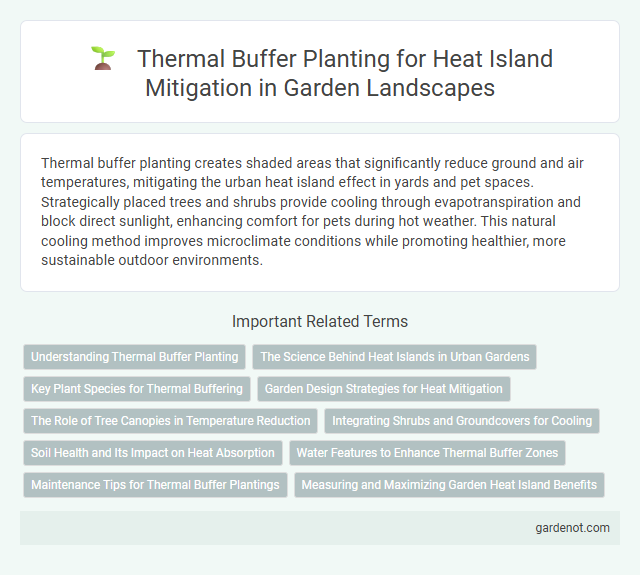Thermal buffer planting creates shaded areas that significantly reduce ground and air temperatures, mitigating the urban heat island effect in yards and pet spaces. Strategically placed trees and shrubs provide cooling through evapotranspiration and block direct sunlight, enhancing comfort for pets during hot weather. This natural cooling method improves microclimate conditions while promoting healthier, more sustainable outdoor environments.
Understanding Thermal Buffer Planting
Thermal buffer planting involves using strategically placed vegetation to reduce heat absorption and lower surface temperatures in urban yards. Selecting plant species with high transpiration rates and dense canopies enhances cooling effects by providing shade and improving air circulation. Understanding the microclimate and soil conditions is crucial for optimizing the thermal buffering capacity and sustaining plant health.
The Science Behind Heat Islands in Urban Gardens
Thermal buffer planting in urban gardens effectively reduces heat island effects by increasing evapotranspiration and providing shade, lowering surrounding air temperatures by up to 5degC. Urban heat islands result from heat absorption by impervious surfaces like concrete and asphalt, which radiate stored heat during the night. Strategic use of vegetation such as trees and shrubs creates microclimates that disrupt heat accumulation and enhance local cooling through natural processes.
Key Plant Species for Thermal Buffering
Key plant species for thermal buffering in heat island mitigation yards include native trees such as Quercus rubra (Northern Red Oak) and Acer saccharum (Sugar Maple) known for their dense canopies and high transpiration rates, which provide effective shading and cooling. Understory shrubs like Cornus sericea (Red Osier Dogwood) and Viburnum dentatum (Arrowwood Viburnum) enhance thermal regulation by reducing ground surface temperatures and improving microclimate conditions. Incorporating perennial grasses such as Panicum virgatum (Switchgrass) further supports heat island mitigation through soil insulation and evapotranspiration, strengthening the overall thermal buffering effect.
Garden Design Strategies for Heat Mitigation
Thermal buffer planting in garden design strategically incorporates dense vegetation and shade trees to reduce surface temperatures and block solar radiation, effectively lowering heat island effects. Selecting plant species with high evapotranspiration rates enhances microclimate cooling, while layering plants in vertical arrangements maximizes shade coverage on pavements and walls. Integrating thermal buffer planting with permeable surfaces improves soil moisture retention, further mitigating urban heat buildup.
The Role of Tree Canopies in Temperature Reduction
Tree canopies play a critical role in temperature reduction by providing extensive shade that directly lowers surface and air temperatures in urban heat islands. The dense foliage of these trees intercepts solar radiation, reducing heat absorption by buildings and pavement, which helps mitigate extreme thermal conditions. Studies show that areas under mature tree canopies can experience temperature drops of up to 7degF (3.9degC), significantly enhancing outdoor comfort and reducing cooling energy demands.
Integrating Shrubs and Groundcovers for Cooling
Thermal buffer planting with shrubs and groundcovers reduces urban heat island effects by providing shade and enhancing evapotranspiration, leading to cooler ambient temperatures. Dense shrub layers minimize heat absorption on surfaces while groundcovers maintain soil moisture and reduce reflective heat from bare ground. Strategic integration of diverse plant species creates microclimates that improve thermal comfort and energy efficiency in urban yards.
Soil Health and Its Impact on Heat Absorption
Thermal buffer planting enhances soil health by increasing organic matter and microbial activity, which improves soil structure and moisture retention. Healthy soils with higher moisture content reduce heat absorption and surface temperatures, effectively mitigating urban heat islands. Enhanced soil porosity and nutrient cycling from thermal buffer plants promote a cooler microclimate critical for sustainable heat island management.
Water Features to Enhance Thermal Buffer Zones
Water features such as ponds, fountains, and bioswales play a critical role in enhancing thermal buffer zones within heat island mitigation yards by promoting evaporative cooling and increasing local humidity levels. Integrating strategically placed water bodies not only reduces ambient temperatures but also supports the growth of thermal buffer planting, improving microclimate regulation. These elements enhance ecosystem services, contributing to effective heat island reduction and improving overall urban thermal comfort.
Maintenance Tips for Thermal Buffer Plantings
Regular watering schedules and soil moisture monitoring are critical for thermal buffer plantings to maintain optimal plant health and enhance heat island mitigation. Pruning and removing dead or diseased foliage ensure proper airflow and maximize the cooling effects of vegetation. Applying mulch helps regulate soil temperature and retain moisture, supporting sustained thermal buffering performance.
Measuring and Maximizing Garden Heat Island Benefits
Thermal buffer planting in heat island mitigation yards significantly reduces ambient temperatures by strategically placing vegetation to block and absorb solar radiation. Measuring effectiveness involves infrared thermography and temperature sensors to monitor localized cooling impacts and soil moisture retention. Maximizing garden heat island benefits requires selecting native, drought-tolerant plants with high transpiration rates and optimizing planting densities to enhance evapotranspiration and shade coverage.
Thermal buffer planting Infographic

 gardenot.com
gardenot.com